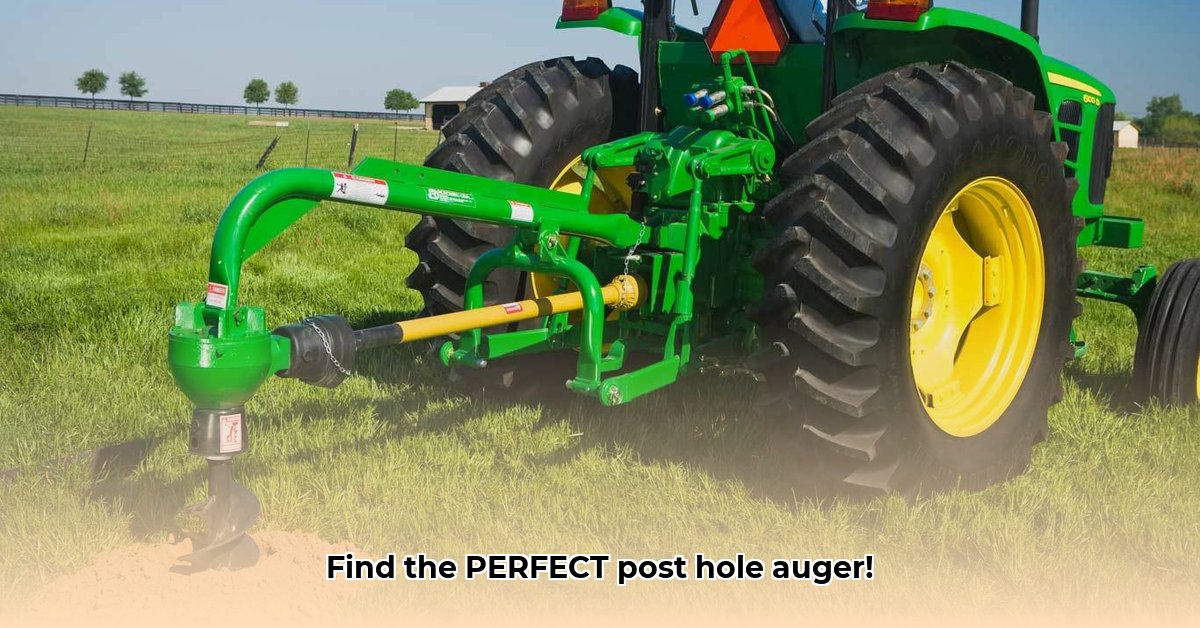
Understanding Your Needs: Project, Soil, and Usage Frequency
Before diving into the specifics of augers, consider your project's demands. What are you building? A simple fence requires less powerful equipment than a large shed or extensive landscaping project. Imagine trying to build a skyscraper with a toy crane; the outcome won't be good. The size and depth of the holes also matter greatly.
Next, assess your soil type. Sandy soil is easily penetrable, while clay or rocky soil demands a more robust auger. This factor heavily influences the torque and RPM you'll need. Finally, estimate your usage frequency. Occasional use justifies a less expensive model, whereas frequent use demands a durable, high-performance auger. Choosing the right tool for the job is crucial; otherwise, you risk damaging your equipment or causing delays in the project. For more information on selecting the right auger, check out this helpful guide: tractor auger guide.
- Pivotal Point 1: Soil type significantly impacts auger selection, requiring different levels of torque and power.
- Pivotal Point 2: Project scope (fence vs. barn) dictates the necessary auger size and power requirements.
- Pivotal Point 3: Usage frequency influences the choice between a budget-friendly option versus a more robust, heavy-duty model.
Types of Post Hole Augers: PTO vs. Hydraulic, and Bit Size Considerations
Compact tractor post hole augers primarily come in two varieties: power takeoff (PTO) and hydraulic. PTO augers connect to your tractor's PTO shaft, offering a cost-effective solution for occasional use. Hydraulic augers, powered by your tractor's hydraulic system, deliver greater control, precision, and power, ideal for larger, more demanding projects. The difference is akin to using a hand drill versus a power drill. A more powerful hydraulic auger allows for superior control and better handling of difficult terrain and dense soil.
Bit size is another critical factor. Smaller bits tackle smaller fence posts easily, while larger bits significantly accelerate progress on larger projects involving substantial posts or tree plantings. Choosing the appropriate bit size is as important as choosing the right auger type.
Key Features to Consider: Torque, RPM, and Safety
Several key features significantly impact an auger's performance and longevity:
- Torque: This measures the auger's twisting power, crucial for navigating tough soils, rocky conditions, or larger bit sizes. High torque translates to faster and more efficient digging.
- RPM (Revolutions Per Minute): This indicates the auger's rotational speed. Higher RPMs are suitable for easier soil, while lower RPMs prevent damage in denser soil. Finding the optimal balance is key.
- Auger Material: Look for robust materials like hardened steel, ensuring durability and resistance to wear and tear, especially in challenging terrains.
- Safety Features: Prioritize safety features like shear pins, designed to protect your tractor and auger from damage under excessive stress. Shear pins will break before the auger or the tractor's components are damaged.
Matching Auger to Tractor: Avoiding Overwhelm
Matching the auger's capacity to your tractor's capabilities is crucial. Don't overload your tractor; consult your tractor's manual to determine its PTO horsepower (for PTO augers) or hydraulic flow rate (for hydraulic augers). Exceeding limits risks severe equipment damage. "Always operate within your tractor's specifications," advises John Miller, Agricultural Engineer at Purdue University.
Installation and Safe Operation: A Step-by-Step Guide
- Secure Attachment: Carefully attach the auger to your tractor, following the manufacturer's instructions precisely.
- Gradual Start: Begin digging slowly to assess soil conditions. Increase speed gradually, avoiding sudden movements.
- Safety First: Always wear safety gear: eye protection, hearing protection, and sturdy gloves.
- Regular Inspections: Inspect the auger and tractor regularly for damage, addressing any issues immediately.
- Proper Storage: Store the auger properly to prevent damage when not in use.
- Emergency Procedures: Familiarize yourself with emergency procedures to ensure safe operation.
Maintenance and Troubleshooting: Extending Auger Lifespan
Regular maintenance is vital for longevity. Lubricate moving parts, inspect for wear, and replace damaged components promptly. Pay particular attention to the auger bits, which will wear down over time; replacing them ensures efficient operation.
Conclusion: The Right Auger for Your Needs
Selecting the right post hole auger is a crucial decision. Consider your project's demands, soil conditions, and tractor capabilities. Understanding the differences between PTO and hydraulic augers and prioritizing safety will lead to a successful and safe digging experience. Remember, the right equipment and safe practices lead to efficient and long-lasting results.